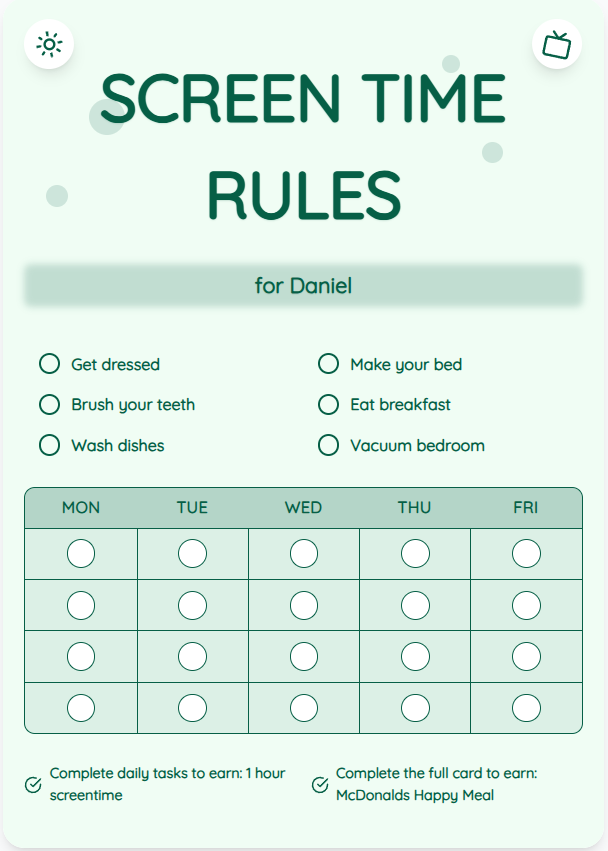How to Successfully Manage Screen Time Limits for Kids
As a parent, managing screen time limits can be challenging. Finding a balance between screen time and other activities is crucial for your child's development. In this guide, we provide practical tips to help you navigate and establish healthy screen time habits for your children aged 2-12.
See What Your Screen Time Chart Will Look Like
Here's an example of a beautiful, customizable screen time rules chart you can create for your family

Understanding the Importance of Screen Time Limits
Setting and enforcing screen time limits is essential for your child's overall well-being. Excessive screen time can impact their physical health, mental development, and social skills. By understanding the importance of these limits, you can make informed decisions that benefit your child in the long run.
Establishing Clear Rules and Consistency
Create clear and consistent screen time rules for your children. Set specific time limits, designate screen-free zones in your home, and enforce consequences for exceeding the limits. Consistency is key to helping your child understand and respect the boundaries you've set.
Put These Tips Into Action
Create a custom chart to implement these strategies with your child
Encouraging Alternative Activities
Encourage your child to engage in alternative activities that promote creativity, physical activity, and social interactions. Provide them with options such as outdoor play, arts and crafts, reading, or family game nights. By offering stimulating alternatives, you can reduce their reliance on screens.
Using Screen Time Charts as a Solution
Screen time charts are effective tools for visualizing and managing your child's screen time usage. Utilize a screen time chart generator like ScreenTimeRules.com to create personalized schedules and track their daily screen time. These charts can help you and your child stay accountable and make adjustments as needed.
Practical Tips for Success
- Set clear boundaries and communicate them with your child.
- Lead by example and limit your own screen time usage.
- Use positive reinforcement to encourage adherence to screen time limits.
- Involve your child in creating their own screen time schedule.
Frequently Asked Questions
How do I handle resistance from my child when enforcing screen time limits?
It's common for children to push back against screen time limits. Stay firm but empathetic, explain the reasons behind the limits, and offer alternative activities to redirect their focus.
What is the recommended daily screen time for children aged 2-12?
The American Academy of Pediatrics recommends no more than 1 hour of high-quality screen time for children ages 2-5, and consistent limits for older children. However, individual needs may vary.
How can I monitor my child's screen time without constant supervision?
Utilize parental control apps or built-in device settings to track and manage your child's screen time remotely. Set up restrictions and alerts to monitor their usage effectively.
By implementing these practical tips and strategies, you can effectively manage screen time limits for your children and promote a healthy balance between technology use and other activities. Remember, consistency and communication are key in establishing positive screen time habits. Explore the benefits of using screen time charts from ScreenTimeRules.com to simplify this process.
Ready to Transform Your Family's Screen Time?
Join thousands of parents who have successfully managed screen time with our customizable charts.
